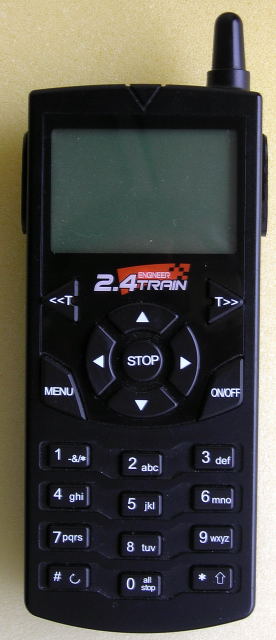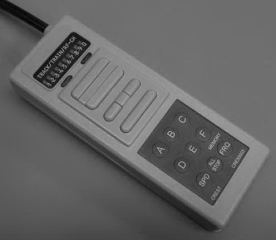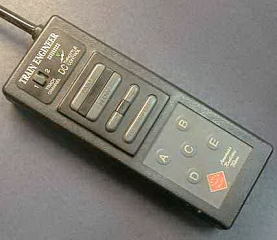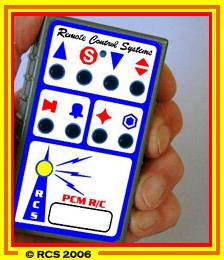Club members must check these tables before programming any throttles they intend to use while operating on the OVGRS club railways in order to eliminate any radio frequency interference with other club members throttles. Any new or deleted throttle settings should be e-mailed to Paul Norton so these tables can be kept current.
ARISTO-CRAFT, REVOLUTION THROTTLE SETTINGS
Aristo-Craft Revolution throttles are pre-programmed with a radio frequency channel and group identification. These are found in main menu under Item 6: Radio Configuration. Unlike previous systems, the Revolution throttle displays all the data for any linked locomotives or power cars. To date the following club members have reported their radio frequency channel and group identification for their Revolution throttles.
| CHANNEL | GROUP | CLUB MEMBER |
| 12 | 7850 | Doug Hayes |
| 13 | 6539 | Chris Lyon |
| 14 | 0425 | Stuart Moxley |
| 16 | 0070 | Doug Hayes |
| 16 | 0105 | Doug Matheson |
| 16 | 0152 | Paul Norton |
| 16 | 0276 | Pat Brennan |
| 16 | 0404 | Henk Van Zijl |
| 16 | 0799 | Malcolm Vant |
| 16 | 5439 | Pat Brewer |
| 16 | 5813 | Steve McKenzie |
| 16 | 0806 | Mike Hamer |
| 17 | 0333 | Colin Churcher |
| 17 | 0806 | Garry Comber |
| 19 | 0812 | Gord Bellamy |
| 19 | 0259 | Gord Bellamy |
| 19 | 3612 | Gord Bellamy |
| 23 | 2604 | Steve&Seanna Watson |
| 26 | 0806 | Paul Anderson |
PLEASE NOTE: These throttle settings can be changed so that each member can assign themselves a different radio frequency channel, so they do not interfere with other operators. If you assign your throttle a new radio frequency channel and/or group identification however, you must re-link any receivers previously programmed.
Two Revolution throttles can be assigned the same radio frequency channel and group identification with the rosters of all locomotives and power cars added to both. This allows the operator to use either throttle to operate any of their locomotives or power cars. This is very handy if a throttle is dropped and disabled.
OLDER ARISTO-CRAFT THROTTLES
PLEASE NOTE: The following tables no longer reference locomotive or power car road numbers, but the throttle settings to operate each one must be reported. Club members are responsible for remembering which throttle settings have been assigned to a particular piece of equipment. Labels on the back of these older throttles are useful for this purpose.
ARISTO-CRAFT, 75 MHZ, THROTTLE SETTINGS
Aristo-Craft, 75 MHz throttles use specific buttons and an LED display to select 10 different radio frequencies and 10 different channels. To date only one club member has reported using this throttle.
| FREQUENCY | CHANNEL | CLUB MEMBER |
| 5 | 2 | Gord Bellamy |
ARISTO-CRAFT, THIRD GENERATION, 27 MHZ THROTTLE SETTINGS
Third-generation Aristo-Craft, 27 MHz throttles use specific buttons and an LED display to select 10 different radio frequencies and 10 different channels. These throttles are used by many club members in locomotives and trailing power cars. To date the following club members have reported using these throttles.
| FREQUENCY | CHANNEL | CLUB MEMBER |
| 1 | 4 | Doug Hayes |
| 6 | 2 | Doug Hayes |
| 6 | 5 | Doug Matheson |
ARISTO-CRAFT, SECOND GENERATION, 27 MHZ THROTTLE SETTINGS
Second-generation Aristo-Craft, 27 MHz throttles use a slide switch to select either Track 1 or 2, and the keypad buttons to set the different radio frequencies and channels. To date only Fred Mills, Gord Bellamy, and Peter Bramah have reported owning these throttles. As Fred uses Track 1, Gord Track 2, and Peter uses a different crystal set, radio frequency interference between these three should not be a problem.
PROGRAMMING THE IPP&W RAILWAY LOCOMOTIVES
Programming these locomotives occurs in two distinct steps. First, the transmitter is programmed to select a transmitter track code. This operation is done on the transmitter alone. Second, a receiver is linked to that transmitter.
1. A transmitter track code is selected by pressing the A and B buttons at the same time (which puts the transmitter in programming mode and causes the LED on the transmitter to flash), and then by pressing one of the ten buttons on the transmitter within 3 seconds. The button that is pressed determines the transmitter’s track code. The transmitter then remembers this track code even if the batteries are removed.
| PROGRAMMING BUTTONS | IPP&W LOCOMOTIVE |
| AB + FASTER | IPP&W #10 |
| AB + SLOWER | IPP&W #11 |
| AB + LEFT | IPP&W #6 |
| AB + RIGHT | UNASSIGNED |
| AB + STOP | UNASSIGNED |
| AB + A | IPP&W #4 |
| AB + B | IPP&W #5 |
| AB + C | IPP&W #8 |
| AB + D | IPP&W #9 |
| AB + E | UNASSIGNED |
2. A receiver is linked to a particular transmitter by pressing the “code set” button on the receiver, and then pressing the “A” button on a transmitter to makes it send its track code. During this time the LED on the receiver will flash and accept the track code being transmitted. When the receiver has been linked, the LED on the receiver will stop flashing.
Momentum could be set while the receiver is being linked by using any of the buttons between “A” and “E”. Button “A” produces shortest momentum and “E” the most momentum. However it is best to use the shortest momentum and control the real momentum by using the fast or slow button on the transmitter with quick taps.
Up to 20 different transmitter and receiver pairs can operate on a single railway. However, since all the transmitters operate on the same RF frequency, when two transmitters are on at the same time (the green LED on the transmitter indicates when it is actually on), they will jam each other and no codes will get through to any of the receivers in range. Throttle changes should be made with a series of button taps, instead of holding the button down.
ARISTO-CRAFT, FIRST GENERATION, 27 MHZ THROTTLE SETTINGS
First-generation, Aristo-Craft, 27 MHz throttles used a slide switch to select either Track 1 or 2, and three small dip switches inside to select the Track Codes. To date no one has indicated they use this type of throttle or receiver.
REMOTE CONTROL SYSTEMS, 27 MHZ, THROTTLE SETTINGS
Remote Control Systems (RCS), 27 MHz throttles are colour coded to and use four small dip switches to select frequency codes. To date the following members have reported using these throttles.
| COLOUR | SWITCHES | CLUB MEMBER |
| Blue | off-off-off-off | Doug Matheson |
| Green | on-on-off-off | Doug Matheson |
| Green | off-on-off-on | Gord Bellamy |
| Green | off-off-off-on | Peter Bramah |
| Yellow | off-off-off-off | Doug Matheson |
| Yellow | off-off-off-off | Gord Bellamy |
| Yellow | on-on-on-off | Gord Bellamy |
| Yellow | on-off-on-off | Stuart Moxley |
| Red | off-off-off-off-on-off | Doug Hayes |
| Yellow | off-on-off-on | Stuart Moxley |





